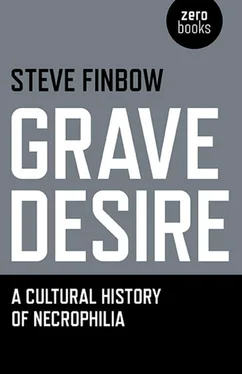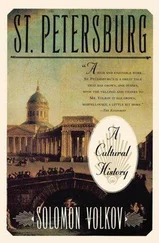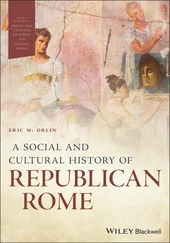‘I pull back the curtains to reveal a wonderful new world—a party, a riot, a ball. It’s the costume affair, Mardi Gras, the Halloween festival, the Day of the dead, and it’s enormous fun to prance around on the arm of inevitable doom. Life is short! Seize the day! Go ahead, darling. Slip me on. Pretend you’re me. See the world through my sockets. Laugh. Live. Love—while you can. Eat, drink, and be merry. What do you think I do? I’m death, and I laugh and make merry too. I dance with skeletons to make goblets out of skulls—to drink from the cranium, you should know, is very fine.’ [29] Necrophilia Variations, p. 194.
Medical definitions: Dorland’s Medical Dictionary for Health Consumers (2007) defines necrophilia as ‘sexual attraction to or sexual contact with dead bodies.’ The American Heritage Medical Dictionary (2007) as ‘An abnormal fondness for being in the presence of dead bodies and sexual contact with or erotic desire for dead bodies.’ Whereas Mosby’s Medical Dictionary, 8 thedition (2009) describes it as ‘a morbid liking for being with dead bodies and a morbid desire to have sexual contact with a dead body, usually of men to perform a sexual act with a dead woman.’ The McGraw-Hill Concise Dictionary of Modern Medicine (2002) puts it more succinctly: ‘A paraphilia in which sexuoerotism requires a corpse, which may involve engaging in sexual activity with same’ or ‘getting a stiffie with a stiff.’
Did that vengeful man whom, living, you could not gratify,
In spite of so much love
Heap upon your indolent, accommodating flesh
The size of his desire?
Answer, O violated corpse! and raising yourself with feverish arm
By your stiff braids,
Tell me, terrifying head, did he press upon your cold teeth
His final farewells? [30] Charles Baudelaire, ‘A Martyred Woman,’ from Selected Poems of Charles Baudelaire, translated by Geoffrey Wagner, (New York, 1974).
The American Psychiatric Association’s Diagnostic and Statistical Manual of Mental Disorders classifies necrophilia as a paraphilia or ‘recurrent, intense sexual urges, fantasies, or behaviours that involve unusual objects, activities, or situations and cause clinically significant distress or impairment in social, occupational, or other important areas of functioning.’ [31] American Psychiatric Association, Diagnostic and Statistical Manual of Mental (4th ed., text rev.). (Washington DC, 2000) p. 535.
Wilhelm Stekel—Sigmund Freud’s ‘apostle’—coined the term paraphilia in 1920; and sexologist John Money, author of Venuses Penuses: Sexology, Sexosophy, and Exigency Theory (1986), Vandalized Lovemaps: Paraphilic Outcome of 7 Cases in Pediatric Sexology (1989) The Breathless Orgasm: A Lovemap Biography of Asphyxiophilia (1991) and Reinterpreting the Unspeakable: Human Sexuality 2000 (1994) popularized the term.
Michel Foucault has argued that it is the multiplicity of our sexual practices that constitute sex; that is, our formative sex lives comprise a complexity of habits, obsession, fantasies, and fetishes. ‘Sexuality must not be thought of as a kind of natural given which power tries to hold in check, or as an obscure domain which knowledge tries gradually to uncover. It is the name that can be given to a historical construct: not a furtive reality that is difficult to grasp, but a great surface network in which the stimulation of bodies, the intensification of pleasures, the incitement to discourse, the formation of special knowledges, the strengthening of controls and resistances, are linked to one another, in accordance with a few major strategies of knowledge and power.’ [32] Michel Foucault, The History of Sexuality, An Introduction, Volume I. trans. Robert Hurley (New York, 1990), p. 160.
The hierarchy of habit, in some cases, leads to paraphilia. Sexual habits: one might prefer oral sex in preparation for orgasm rather than full intercourse. Some prefer intercourse in the missionary position, some reverse cowgirl. A narrative representation of this is enacted in the majority of pornographic films: kissing, undressing, breast fondling, masturbation of the female, masturbation of the male, oral sex with female, oral sex with male, missionary position, cowgirl, reverse cowgirl, doggy-style, anal missionary, anal cowgirl, anal reverse-cowgirl, anal doggy-style, exterior male orgasm. The transferability of desire from a living sexual partner to a corpse is a progression of perversity. A redetermination—recombination—of molecules appears normal. ‘Yes, all becomings are molecular: the animal, flower or stone one becomes are molecular collectivities, haecceities, not molar subjects, objects, or form that we know from the outside and recognize through experience, through science, or by habit. [33] A Thousand Plateaus: Capitalism and Schizophrenia, p. 275.
These perverse progressions, these narrative sexual successions show formalized habits apparent (with variations) in most pornographic movies. The final act—the male orgasm—is closure, the secession of habit. ‘Habits are the very stuff our identities are made of. In them, we enact and thus define what we effectively are as social beings, often in contrast with our perception of what we are.’ [34] Violence, pp. 164-5.
Or as Jo Nesbø’s Harry Hole would argue, ‘There is a pattern. There’s always a pattern. Not because you plan it, but because all humans are creatures of habit, there’s no difference between you and me and the rapist.’ [35] Jo Nesbø, The Bat, (London, 2012), p. 109.
Replacing Žižek’s ‘social’ with ‘sexual’ creates obsession, the next stage in the hierarchy of habit. In recent years, the celebrity-obsessed stalker has become a media stock villain. However, the most common form of stalking divides into two main classifications—psychotic and non-psychotic—and five sub-groups: ‘Rejected stalkers pursue their victims in order to reverse, correct, or avenge a rejection (e.g. divorce, separation, termination). Resentful stalkers pursue a vendetta because of a sense of grievance against the victims—motivated mainly by the desire to frighten and distress the victim. Intimacy seekers seek to establish an intimate, loving relationship with their victim. To them, the victim is a long-sought-after soul mate, and they were ‘meant’ to be together. Incompetent suitors, despite poor social or courting skills, have a fixation, or in some cases a sense of entitlement to an intimate relationship with those who have attracted their amorous interest. Their victims are most often already in a dating relationship with someone else. Predatory stalkers spy on the victim in order to prepare and plan an attack—usually sexual—on the victim.’ [36] See Paul E. Mullen Michele Pathé, and Rosemary Purcell, Stalkers and Their Victims (Cambridge, 2000).
Only the predatory stalker is psychotic and obsessed with sex—Sergeant Bertrand fits into this category. But sexual obsession takes other forms. Sexual obsession is a form of obsessive compulsive disorder in which the person obsesses either about a person, his/her sexuality, or a means by which he/she achieves sexual gratification—a ritualized habit to distinguish it from fantasy—fabricated habit. Person ‘A’ may be obsessed with Japanese women. ‘B’ with hairy, overweight men. ‘C’ with seamed stockings. ‘D’ with studded butt plugs. The ritualized habit is a means towards orgasm but not the sole means. Habit plus obsession leads us to a Balkanization of sex within the pornographic industry—films and magazines that cater for many different needs: women over 50, hairy men, dwarves, ladyboys, redheads, Asian girls, twinks, BDSM, etc. Fantasy, then, becomes another component in the hierarchy of habit.
Читать дальше












